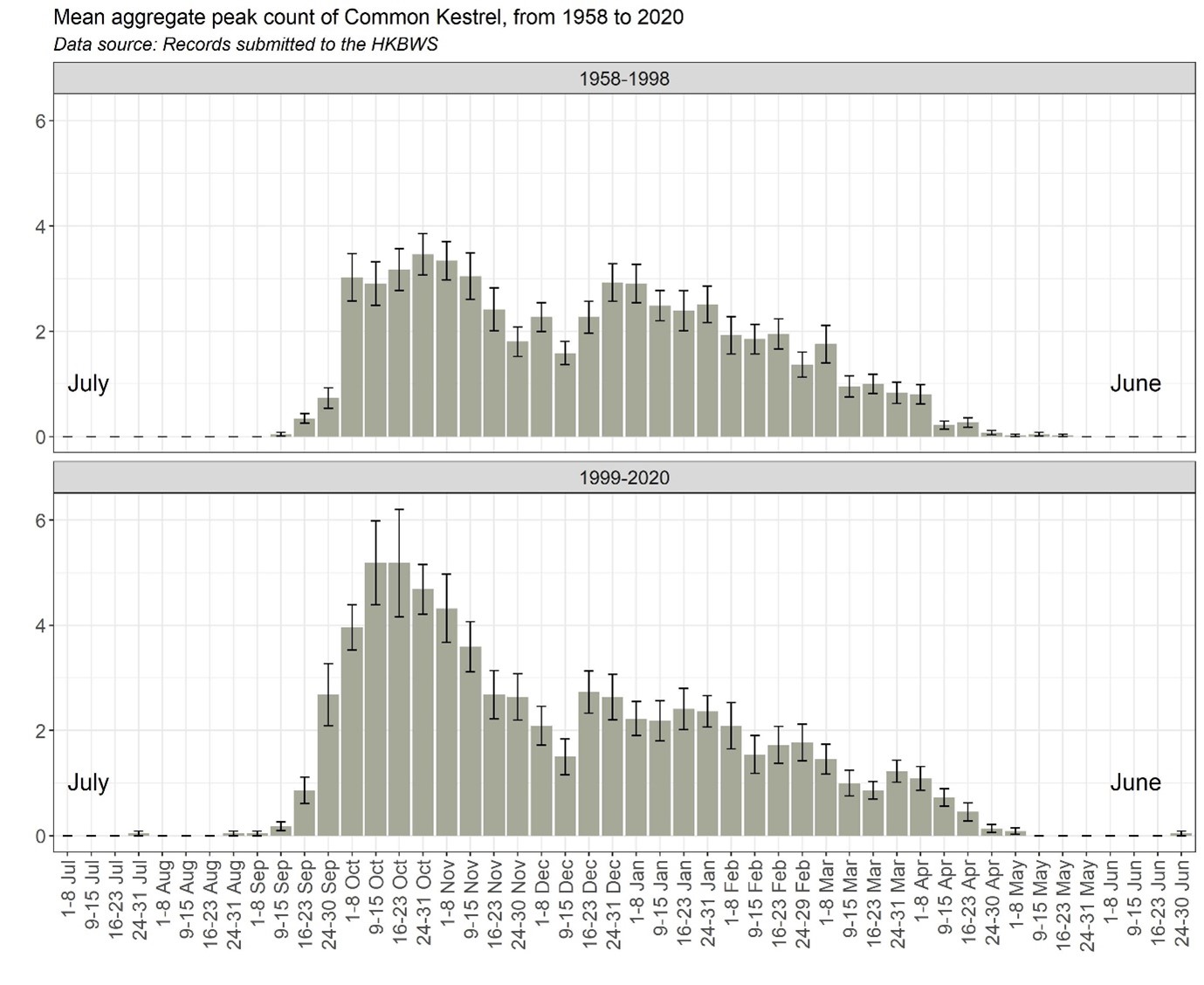Common Kestrel Falco tinnunculus 紅隼
Category I. Common passage migrant in autumn, uncommon winter visitor, scarce passage migrant in spring and very rare in summer; occurs in open country areas.
IDENTIFICATION

Oct. 2022, Wellington Ngai.
27-35 cm. Long-tailed falcon with blunt wing tips that uses prolonged hovering to locate prey. Level flight involves little gliding on narrow wings (unlike accipiters).

Jan. 2023, Benjamin Li. Adult male.
Adult male distinguished by grey rump and tail with broad black tip, grey head, orange-brown mantle and inner wing coverts with black spots and warm buff underparts.

Dec. 2019, Kinni Ho. First-winter male.
Some black-spotted chestnut scapulars and a single adult-type tail feather indicate this is a first-winter male. Adult female has brown rump and upper tail with broad brown tip and black barring, warm brown upperparts with broad black barring, dull creamy underparts with broad streaks and closely streaked head.

Dec. 2019, Kinni Ho. First-winter male.
This photograph of the same first-winter male shows the bolder underpart streaks compared to adults and the greyish at the base of the tail shown by young males.
VOCALISATIONS
The most commonly heard call in Hong Kong is repeated high-pitched ‘kee-kee-kee…’
DISTRIBUTION & HABITAT PREFERENCE
Common Kestrels occur in widespread areas throughout the New Territories, HK Island, Lantau and outlying islands where they utilise a wide variety of open habitats in both rural and urban-edge areas, including marshes, fish ponds, agricultural areas, grassy hills, in-filled fish ponds, reclamations and airfields. Since its opening in 1998, the extensive areas of grass at the airport have brought most of the highest counts.
Common Kestrel has almost entirely disappeared from the urban areas of Kowloon and HK Island where it was once regularly sighted in winter. As with Eastern Buzzard, this may be due to the disappearance of semi-natural urban edge habitat.
OCCURRENCE
Most records of Common Kestrel are from late September to early April, with peak numbers during autumn passage in October and the first half of November (Figure 1). Excluding two substantiated summer records, which occurred on 27 July 2000 and 26 June 2004, extreme dates are 5 September 2002 and 22 May 1993. Since 1999, however, the latest record is only 3 May.
Most reports are of one or two birds, but occasionally loose flocks of up to five are seen in autumn. The highest count is ten at Lau Fau Shan on 6 November 1968, while the highest this century is nine at the airport on 9 October 2002.
Although Figure 1 indicates there has been no significant change in the pattern of occurrence, it does suggest there has been a decline in numbers in autumn as, despite an increase in observer activity, the mean aggregate weekly count is lower.
No other changes in status are indicated by historical literature. After first being reported by Swinhoe (1861), it was widely regarded as a common winter visitor (Kershaw 1904, Vaughan and Jones 1913, Aylmer 1932, Herklots 1953).
BEHAVIOUR, FORAGING & DIET
Performs characteristic hovering on rapid wing beats with drooped and spread tail over open country as it searches for prey. Unidentified birds, bats, reptiles (including snakes and Changeable Lizard Calotes versicolor) and both aerial and terrestrial insects are the only food items reported, though there have been reports of attempted predation of Feral Pigeon, Little Swift, larks, pipits, Dusky Thrush, Eurasian Tree Sparrow, Red-billed Starling and a caged canary. Herklots (1967) described how individuals gathered at hill-fires and searched for prey by hovering in hot air-currents ahead of the line of flames.
RANGE & SYSTEMATICS
Widespread in Africa, Europe and Asia between 70oN and 35oS, absent only from deserts and high-altitude areas. Western populations tend to be either resident or only partially migratory, while east Asian populations migrate longer distances (Orta et al. 2020). In China a summer visitor to the northwest and northeast and present all year in the remaining lowland areas of the country (Liu and Chen 2020) in much of which a mix of resident and migratory birds occurs. Vaughan and Jones (1913) reported Common Kestrel nesting in northern Guangdong, and it still occurs there in summer (Lewthwaite 1996), though there is no evidence of breeding in HK.
Polytypic. The nominate subspecies occurs from Europe to Siberia, while F. t. perpallidus breeds from northeast Siberia to northeast China and the Korean peninsula and F. t. interstinctus breeds from the Himalayas east to Japan and Indochina. All records in HK appear to be of the darker and more heavily marked interstinctus.
CONSERVATION STATUS
IUCN: Least Concern. Population trend decreasing.
Figure 1.

Aylmer, E. A. (1932). The birds of Hong Kong. Part IX. Order Accipitres (Falcons, Kites, Buzzards, Eagles, Hawks, etc.). Hong Kong Naturalist 3: 3-5.
Dove, R. S. and H. J. Goodhart (1955). Field observations from the Colony of Hong Kong. Ibis 97: 311-340.
Herklots, G. A. C. (1953). Hong Kong Birds. South China Morning Post, Hong Kong.
Kershaw. J. C. (1904). List of birds of the Quangtung Coast, China. Ibis 1904: 235-248.
Liu, Y. and Y. H. Chen (eds) (2020). The CNG Field Guide to the Birds of China (in Chinese). Hunan Science and Technology Publication House, Changsha.
Orta, J., P. F. D. Boesman, and J. S. Marks (2020). Eurasian Kestrel (Falco tinnunculus), version 1.0. In Birds of the World (S. M. Billerman, B. K. Keeney, P. G. Rodewald, and T. S. Schulenberg, Editors). Cornell Lab of Ornithology, Ithaca, NY, USA. https://doi.org/10.2173/bow.eurkes.01
Vaughan, R. E. and K. H. Jones (1913). The birds of Hong Kong, Macao and the West River or Si Kiang in South-East China, with special reference to their nidification and seasonal movements. Ibis 1913: 17-76, 163-201, 351-384.
Walker, F. J. (1958). Field observations on birds in the Colony of Hong Kong. Hong Kong Bird Watching Society, Hong Kong (duplicated).

